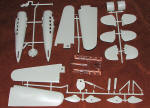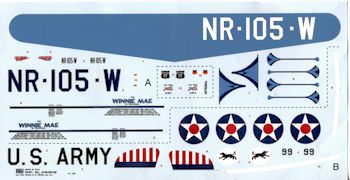
ESCI/ERTL 1/48 Lockheed Vega
| KIT #: | 4100 |
| PRICE: | $Traded for it |
| DECALS: | Two options |
| REVIEWER: | Scott Van Aken |
| NOTES: | Out of production |

| HISTORY |
Designed by John Knudsen Northrop and Gerard Vultee, both of whom would later form their own companies, the aircraft was originally intended to serve with Lockheed's own airline routes. They set out to build a four-seat aircraft that was not only rugged, but the fastest aircraft as well. Utilizing the latest designs in monocoque fuselages, cantilever wings and the best engine available, the Vega delivered on the promise of speed.
The fuselage was monocoque, built from sheets of plywood, skinned over wooden ribs. Using a large concrete mold, a single half of the fuselage shell was laminated in sections with glue and then a rubber bladder was lowered into the mold and inflated with air to compress the lamination into shape. Two fuselage halves were then nailed and glued over a previously made rib framework. With the fuselage constructed in this fashion, the wing spar had to be kept clear, so a single spar cantilever was mounted atop the aircraft. The only part of the aircraft that wasn't particularly streamlined was the landing gear, although production versions wore sleek "spats". It was powered by the Wright Whirlwind, which delivered 225 horsepower (168 kW).
| THE KIT |
 This is, of course, the old AMT kit in an ESCI box, which means it is around
20 years old as ESCI went out of business in the 1980s. Italeri now has access
to the ESCI molds, but has not felt like reissuing any of these Golden Age kits.
It may be that AMT still has the molds.
This is, of course, the old AMT kit in an ESCI box, which means it is around
20 years old as ESCI went out of business in the 1980s. Italeri now has access
to the ESCI molds, but has not felt like reissuing any of these Golden Age kits.
It may be that AMT still has the molds.
Anyway, this kit is molded in a light grey plastic and while pretty much flash free, there are some rough edges to the mating surfaces that will need to be attended to.
The kit has no real cockpit or cabin. There is a cockpit bulkhead with a piece jutting out of it on which to place a pilot figure. Since little can be seen through the rather thick clear bits, this will suffice. Cabin windows are separate and can be installed from the outside, which alleviates the need for masking these items.
Fin and tailplanes are two piece and butt fit. Once done, they will fit into slots in the fuselage. Wings are an interesting construct. One is supposed to install the lower wing halves onto the completed fuselage first. Then the upper wings, which join in a sturdy manner, are then glued on. Test fitting has shown that this works quite well. It also showed that for some of the smaller parts that have alignment pins, it is best to remove those pins as they do not line up perfectly.
There is a rather nicely detailed engine face that fits into two cowling halves before attaching to the airframe. The landing gear is quite sturdy looking and the wheels are molded into the spat halves.
 The kit instruction sheet is huge with most of either side taken up with a
markings and painting guide. All of the drawings are large and due to the
simplicity of the kit, should cause no issues. Markings are for two planes. One
is the famous "Winnie Mae", flown by Wiley Post in 1933. The other is for a US
Army Y1C-12 with yellow wings and blue fuselage. To be really accurate, the
Y1C-12 should not have spatted wheels. The large decal sheet is well printed and
my copy still may be viable as it has not yellowed.
The kit instruction sheet is huge with most of either side taken up with a
markings and painting guide. All of the drawings are large and due to the
simplicity of the kit, should cause no issues. Markings are for two planes. One
is the famous "Winnie Mae", flown by Wiley Post in 1933. The other is for a US
Army Y1C-12 with yellow wings and blue fuselage. To be really accurate, the
Y1C-12 should not have spatted wheels. The large decal sheet is well printed and
my copy still may be viable as it has not yellowed.
| CONCLUSIONS |
The version on floats is pretty easy to come by, but the wheeled version will require some searching. It would be great if this kit was reissued along with the other three in the series. They are easy to assemble and while not very detailed, it allows the detailers a chance to test their skills if they wish. Aftermarket decals are available for this aircraft from Red Pegasus and I fully intend to build mine using some of their markings.
| REFERENCES |
http://en.wikipedia.org/wiki/Lockheed_Vega
October 2013
Thanks to me for the preview kit.
If you would like your product reviewed fairly and fairly quickly, please contact the editor or see other details in the Note to Contributors.